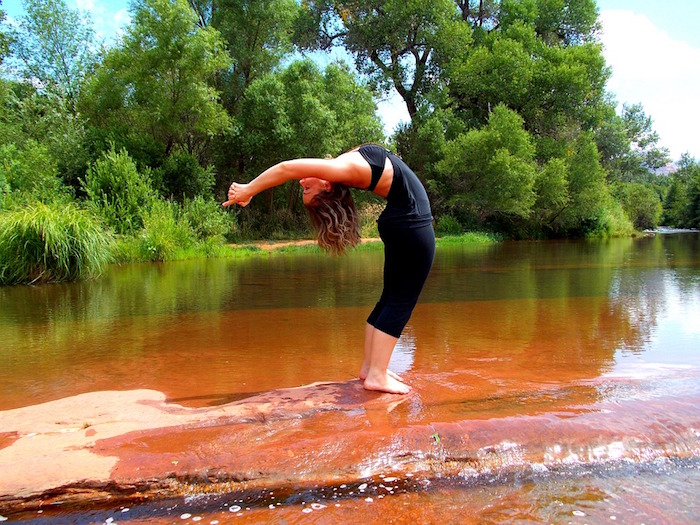
“Yoga is not a means to get somewhere, as if you were not somewhere already. It is your direct and intimate participation with life.” ~ Mark Whitwell
As we all know, yoga is in. It’s the fad of the century. People love it.
Here’s the thing: Most of the yoga being done out there technically shouldn’t be called yoga.
Calisthenics? That brings to mind an image of a row of people doing jumping jacks and squats. Gymnastics? Yoga (usually) doesn’t involve flips or uneven bars. Stretching? Too general.
Nowadays, everything under the sun is referred to as yoga. It’s a fact of life I’ve come to accept.
For years, I’ve joked that I teach in the lineage of Yoga Schmoga when introducing myself to a new circle of yogis prior to leading a practice. Or when answering that eternal question, “What kind of yoga do you teach?”
I do teach Yoga Schmoga, in that I have neither an official lineage nor a single guru. I study various aspects of practice or modalities, like asana, pranayama, mindfulness, dharma, metta, chakras, yin yoga, human development, partner yoga, and meditation.
I spent the first 32 years of my life living in cities: Austin, London, Palo Alto, Austin again, Guatemala City. Now, I live in the woods, near the shoreline of Lake Atitlan, a gorgeous, world-famous volcanic lake I’d never heard of prior to living in Guatemala. All this is to say, my lifestyle (a.k.a. my life) has become more and more authentically au natural in recent history.
“Happiness arises when you relax into the reality of your natural condition. The secrets of the universe are already in you as you. Seeking anything implies that you don’t have it; every search for the idea of enlightenment leads you further away from it. The magnificence of life does not await you—it actually is you.” ~ Mark Whitwell
I have come to a few shocking conclusions.
- Yoga mats are completely unnecessary.
- Practicing yoga in a studio is not ideal.
- Yoga certifications and trainings are largely meaningless, if not a waste of time.
Natural yoga is practiced outdoors in the fresh air.
Or indoors in a truly ecological space, and on an ecological mat such as one made of bamboo or sheepskin.
This is not to say that I never use my fancy Jade yoga mat. I do, sometimes. Because old habits die hard. And because some floors on which I practice/teach are cold, slippery and/or dirty. However, ideally, I adore practicing on wood floors, in the grass, or on the sand at the beach.
For standing poses, a mat is not necessary on any of those types of terrain. For seated or reclining poses, a blanket, towel, sheepskin or sarong can do the trick, if you don’t want to lie directly on the floor, grass or sand for whatever reason.
Natural yoga is free.
It doesn’t cost a dime. It doesn’t require a 10-class pass or monthly membership.
This is not to say you should never pay for yoga or practice in a gym or yoga studio. These can be great gateways to natural or actual yoga. And if the teacher is quality, it’s a worthwhile investment of your time, energy and money. Which brings me to my final point for today:
Natural yoga is learned one-on-one, directly from a qualified, experienced teacher.
The yoga industry is the child of the storybook marriage between yoga and American capitalism. The wedding was back in the sixties, but the monster baby wasn’t born until the 21st century. The ever-expanding yoga industry not only manufactures a bazillion yoga mats, pants and props, it also purports to train and certify yoga instructors.
I, myself, became a Register Yoga Teacher, once upon a time. Even while I was still living in the States, I chose not to renew my membership, seeing as Yoga Alliance offered me nothing but three silly initials in exchange for my annual dues.
If you want to be a yoga teacher, practice yoga. For a long time, in a devoted way. You will know when it’s time to start teaching. You will continue to study, learn, grow and change. Go ahead and participate in a 200 or 500-hour training, if you must. Just know that that is the beginning (not the end) of your professional training.
Research teachers. Why be trained by someone who’s been practicing, however diligently, for a handful of years, when you could study under a wise elder who has lived their yoga for decades?
I hope this article has ruffled your feathers a little and that it will help inspire you to practice more and more actual, natural yoga!
Relephant:
3 Ways to Return our Yoga Practice to Nature.
~
Author: Michelle Margaret Fajkus
Editor: Travis May
Image: Pixabay








Read 3 comments and reply